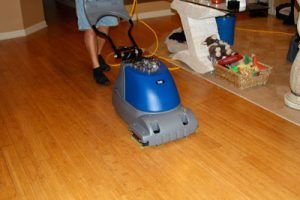How To Clean Hardwood Floors
Determining the Finish
The first step in devising a method for cleaning a hardwood floor is to determine the type of finishing a hardwood floor has got or the kind of material the hardwood floor is sealed with. The most common type of finishing employed in hardwood floors is surface sealing. All they need to be cleaned is a mop and a sweep because these floors are stain resistant and hardly damaged by water. The oil treated hardwood floors need greater care and should be cleaned using wax, in either liquid or paste form. Lacquered and varnished hardwood floors should also be treated with wax. The same goes for untreated floors.
 Another important factor that needs to be kept in mind is the condition the finish is in because it is mainly the finish and not the underlying wood that has to be cleaned. If the finish is damaged or worn out, water must not be employed as one of the cleaning agents while cleaning it. On the other hand, if the sealing is in a very good condition, it can safely be treated with water.
Another important factor that needs to be kept in mind is the condition the finish is in because it is mainly the finish and not the underlying wood that has to be cleaned. If the finish is damaged or worn out, water must not be employed as one of the cleaning agents while cleaning it. On the other hand, if the sealing is in a very good condition, it can safely be treated with water.
Stain Removal From Polished Floors
In order to remove water stains from a waxed hardwood floor, the stained area should be rubbed with No. 2 type steel wool. For more stubborn stains, sand paper should be used to sand the spot. It should then be cleaned using steel wool type No.1 or No. 00 and solutions known as mineral spirits. The refinishing of the floor should follow such a treatment.
In order to eliminate cigarette burns, the hardwood floor should be rubbed with steel wool that has been moistened with adequate amounts of soap and water. Marks left on a hardwood floor by heels and casters should be rubbed with fine type steel wool moistened with a floor cleaner. After wiping it dry, it should be polished once again. Ink spots should be dealt with steel wool type 2 and regular floor cleaners. Scuffmarks should be treated with a damp sponge on which a small quantity of baking soda has been applied. Food stains can be wiped with a piece of damp cloth followed by floor polishing or wax.
Ice should be rubbed against chewing gums and other sticky substances in order to remove them off the hardwood floor. Pouring flour cleaners around them can also loosen such substances. The most effective method of removing alcohol spots is rubbing them either with liquid wax or with paste wax. The best technique employed in removing the stains is to start rubbing from the edges and going towards the spot’s center in order to keep it from spreading. Care should be taken to remove the mud, liquids and spills immediately before they seep deep into the wood.
Regular Hardwood Floor Cleaning Methods
The equipment used for regular cleaning of hardwood floors is a canister vacuum, which has special attachments for bare floors that help absorb the dust effectively. The second important equipment is a dust mop having a cotton head ranging from 12 inches to 18 inches in length. It is used in conjunction with a treatment designed specially for the dust mob. The treatment is sprayed on the head of the mob, usually about 12 hours to 24 hours before the commencement of mopping.
The fastest and most effective method employed to deep clean hardwood floors is damp mopping. The frequency of damp mopping needed depends on the usage of the floor. Places that are used more often should be mopped once a week. Areas that are not in frequent use should be mopped only once during a month. A wood cleaner having a neutral pH or the products recommended by manufacturers should be used with water for damp mopping. To ensure safe and proper cleaning, the mop should be twisted after wetting it so that it is almost half dry. This is necessary because water can prove harmful for the wood.
Heavy duty mopping employs extra water for cleaning. It is suitable only for properly sealed hardwood floors.
Using Vinegar on Hardwood Floors
The use of vinegar is regarded as one of the best methods for cleaning hardwood floors. The main advantages associated with this technique are its low cost and high degree of effectiveness. White vinegar serves extremely useful for removing grease and eliminating unpleasant odors. Plus it serves beneficial in removing wax deposits, multiple types of stains and mildew.
Usually half a cup of white vinegar is mixed with a gallon of adequately warm water and is used as a floor cleaner. Vinegar can also be employed for cleaning hardwood floors by using manufactured products that contain it as a large part of their ingredients. These products are highly effective in giving a shine to the floors.
Products That Should or Shouldn’t Be Used on Hardwood Floors
It is advised to use cleaning products that are recommended by the finishers themselves. If these are too costly or not easily available, plain soap mixed with water can be used instead. The use of strippers for removing wax, chewing gums and other solid deposits is encouraged. Liquid wax and paste wax specially designed for hardwood floors is fit for use. Cleaners with neutral pH should only be used. The use of oils and furniture sprays for cleaning purpose should be avoided.
Strong cleaners like ammonia and alkaline solutions tend to damage or dull the floor finish and hence should not be used. Water should not be used alone for cleaning hardwood floors because it tends to discolor the surface. Besides, water alone does not clean very well either. Use of excess water is strictly prohibited because it can create swellings and cracks in the wood floor. Water based waxes are not recommended because they often tend to produce a white discoloration.
Urethane finished floors should not be treated with any kind of wax and need cleaners that do not leave a residue. Use of oil soaps should be avoided because they give rise to certain problems while putting on a maintenance coat. Vacuum cleaners having beater bars should not be used because they are likely to produce dents on the wood surface.
VIDEO: cleaning wooden floors

